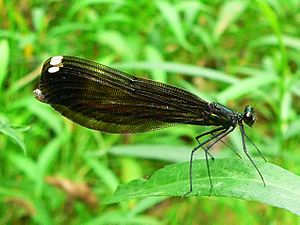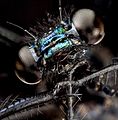Ebony jewelwing facts for kids
Quick facts for kids Ebony jewelwing |
|
|---|---|
 |
|
| male | |
 |
|
| female | |
| Conservation status | |
| Scientific classification | |
| Kingdom: | |
| Phylum: | |
| Class: | |
| Order: | |
| Suborder: | |
| Family: |
Calopterygidae
|
| Genus: | |
| Species: |
C. maculata
|
| Binomial name | |
| Calopteryx maculata (Palisot de Beauvois, 1807)
|
|
The ebony jewelwing (Calopteryx maculata) is a beautiful type of damselfly. It's known for its broad wings. This insect is one of about 150 species in its family, called Calopterygidae. You can find ebony jewelwings in the eastern United States and southeastern Canada. They live as far west as the Great Plains. People sometimes call them the black-winged damselfly.
Contents
What Does It Look Like?
Ebony jewelwings are fairly small, usually between 39 and 57 millimeters (about 1.5 to 2.2 inches) long.
Male Ebony Jewelwing
The male ebony jewelwing has a shiny, metallic blue-green body. Its wings are completely black.
Female Ebony Jewelwing
The female is a bit different. Her body is a duller brown color. Her wings are smoky, not black, and they have small white spots near their tips.
Young Damselflies (Naiads)
When ebony jewelwings are young, they are called naiads. These young damselflies are pale brown with darker marks on their bodies.
Where Do They Live?
Ebony jewelwings like to live near streams and rivers that have lots of trees around them. They can sometimes fly quite far away from the water, too.
How Do They Have Babies?
Ebony jewelwings mate during the summer months.
Mating Process
When they mate, the male holds onto the female's head with the end of his body (his abdomen).
Laying Eggs
After mating, the female lays her eggs. She places them inside the soft stems of aquatic plants that grow in the water.
Naiad Development
The young damselflies, or naiads, live in the water. They eat small insects that also live in the water. When a naiad has grown big enough, it crawls out of the water. Then, it sheds its skin in a process called molting. This is how it changes into an adult damselfly.
When Can You See Them?
You can see ebony jewelwings flying for most of the year in some areas. They have a long flight season.
Who Eats Them and What Do They Eat?
Ebony jewelwings are part of the food chain.
What Ebony Jewelwings Eat
As adults, ebony jewelwings hunt and eat smaller insects. This includes things like mosquitoes and gnats. The naiads, living in the water, eat tiny aquatic insects.
Who Eats Ebony Jewelwings
Many animals like to eat ebony jewelwings. Birds such as robins and blue jays hunt them. Reptiles like turtles and frogs also eat them. Fish, including bass and perch, will catch them in the water. Even other insects, like large dragonfly species, can be predators.
Where They Hide
Ebony jewelwings often hide among different kinds of plants and algae that grow near the water. This helps them stay safe from predators.
Gallery
-
On a palmetto plant






